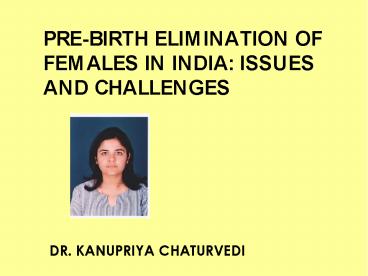PRE-BIRTH ELIMINATION OF FEMALES IN INDIA: ISSUES AND CHALLENGES - PowerPoint PPT Presentation
Title:
PRE-BIRTH ELIMINATION OF FEMALES IN INDIA: ISSUES AND CHALLENGES
Description:
79% of the total 577 districts in the country registered a decline in CSR between ... Media advocacy to encourage greater focus on the issue of female foeticide ... – PowerPoint PPT presentation
Number of Views:529
Avg rating:3.0/5.0
Title: PRE-BIRTH ELIMINATION OF FEMALES IN INDIA: ISSUES AND CHALLENGES
1
PRE-BIRTH ELIMINATION OF FEMALES IN INDIA ISSUES
AND CHALLENGES
- DR. KANUPRIYA CHATURVEDI
2
SITUATION ANALYSIS
- Sex Ratio - 933 females per 1000 males (Census
2001) - Child Sex Ratio (0-6 years) - 927 females per
1000 males (Census 2001)
3
CHILD SEX RATIO 1991 - 2001
2001
1991
Child Sex Ratio (0-6) lt 921 922 - 968 gt
969 Missing data
4
- 79 of the total 577 districts in the country
registered a decline in CSR between 1991 2001 - 204 or about 35 of the districts registered
child sex ratios below the national average of
927 females per 1000 males - 49 districts recorded child sex ratios below 850
- Punjab with 82 points decline has the highest
reduction in the CSR, followed by Haryana with 59
points - 754 girls per 1000 boys is the lowest district
level CSR recorded - Punjab - Sharper CSR decline in urban areas (32 points in
2001) than in the rural (14
points) - Urban child sex ratio is 903 females per 1000
males (2001 Census) and rural child sex ratio is
934 females per 1000 males - Only 4 states (Kerala, Mizoram, Tripura Sikkim)
and 1 union territory (Lakshadweep) out of the 35
states and UTs, recorded an increase in CSR in
2001 - 1036 girls per 1000 boys is the highest district
level CSR recorded - Sikkim
5
DISTRICT LEVEL CHILD SEX RATIO - 2001
6
- States in the frontline of economic progress like
Haryana, Punjab, Delhi, etc., have recorded the
sharpest decline in child sex ratios. - State/UT Child sex ratio Poverty Ratio ( of
population living - (0-6 years females below poverty line)
1999-2000 per 1000 males) (combined - High Income States
- Delhi 865 8.23
- Gujarat 878 14.07
- Haryana 820 8.74
- Himachal Pradesh 897 7.63
- Punjab 793 6.16
- Maharashtra 917 25.02
- Low Income States
- Sikkim 986 36.55
- Tripura 975 34.44
- West Bengal 963 27.02
- Orissa 950 47.15
7
IMPLICATIONS
- Imbalanced sex ratios an indication of
deep-rooted gender bias, undermines
the right to life of girls - Pre-birth elimination of girls creates scarcity
of women, which may result in - Girls being married at younger age
- Increased numbers of child brides further
contribute to - the poor status of women, as they are less
likely to finish - school or develop job skills before marriage
- Young brides and their children are more likely
to suffer - from increased morbidity and mortality
associated with - early childbirth
- Increase in acts of violence against girls and
women, e.g., - rape, abduction, trafficking, due to surplus
of men - Loss of women likely to have negative
consequences on the economy since women are a
vital part of Indias labour force
8
Government's response continued..
- Implementation strategy focuses on
- Advocacy and communication Mobilising media
both print and electronic to create nation-wide
publicity and awareness - Capacity building Ranges from organising
training programmes to provisioning of essential
reading materials to equip and enhance knowledge
base - Promoting, strengthening and working with
partners - The GOI works with a range
of partners, particularly other departments like
the Department of Women and Child Development,
the Registrar Generals Office, NGOs, civil
society organisations, academic institutions, UN
agencies, etc.
9
WHAT SHOULD BE DONE
- Media advocacy to encourage greater focus on the
issue of female foeticide - Strengthen partnerships and alliances to
facilitate the implementation of laws, policies
and programmesthat protect the rights of girls - Support research studies and data analysis
- Support community based initiatives
10
FUTURE DIRECTIONS...
- Promote community based inter sectoral actions to
address adverse sex ratios - Improve civil registration system for births,
deaths and ante-natal registrations - Support advocacy efforts to ensure the practice
of medical ethics and work with State and
National Medical Counsels - Develop related indicators to help in monitoring
progress - Document and disseminate information
- Continue media advocacy and efforts to facilitate
the implementation of laws, policies and
programmes that protect the rights of girls.































